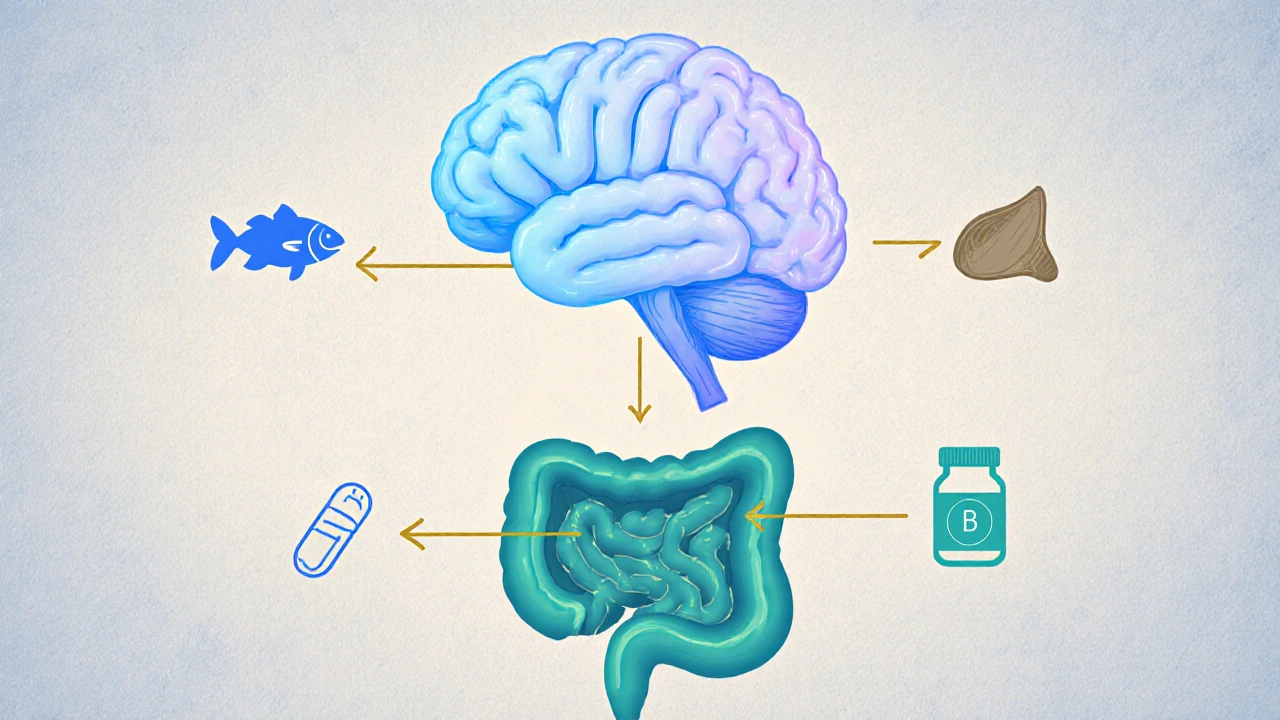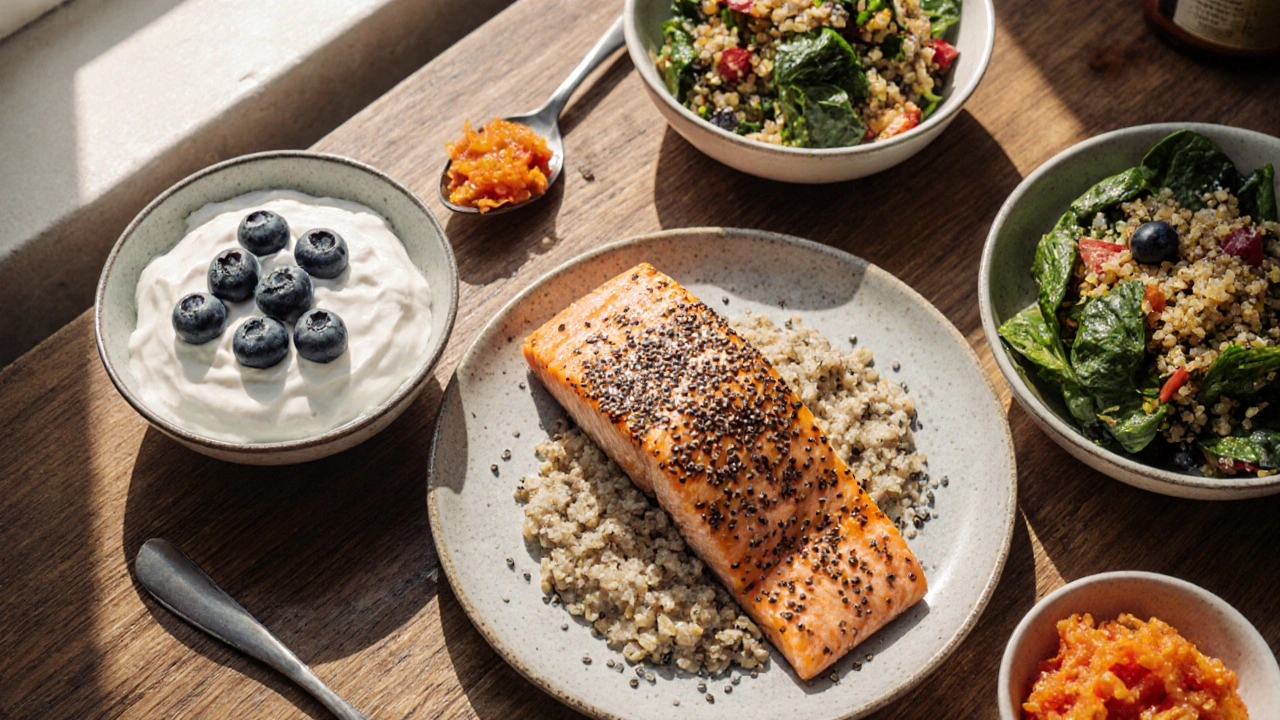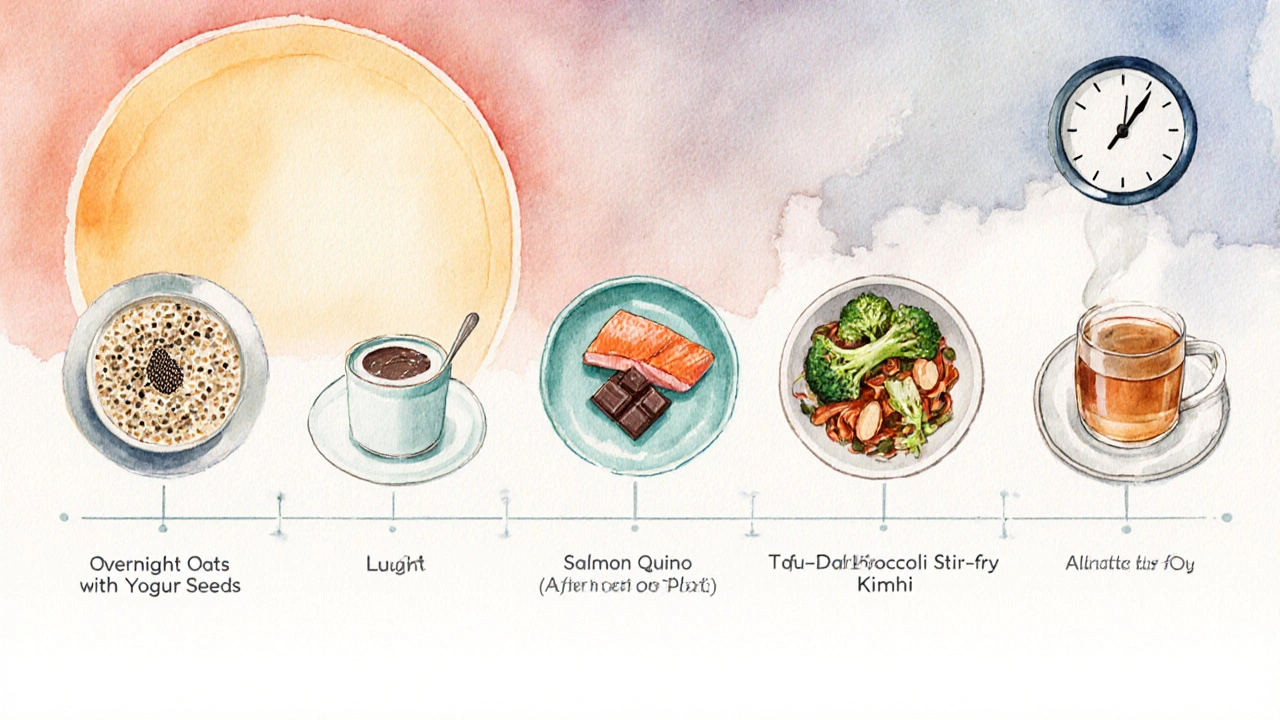How Nutrition Helps Manage Panic Disorder

Panic Attack Trigger Tracker & Nutrition Advisor
Enter your food and symptoms to see personalized analysis.
Key Takeaways
- Specific nutrients can lower the frequency and intensity of panic attacks.
- Balancing gut health supports brain chemistry linked to anxiety.
- Limiting caffeine, refined sugar, and alcohol reduces common triggers.
- A simple meal plan can be built around omega‑3s, magnesium, B‑vitamins, and probiotics.
- Track symptoms and food intake to fine‑tune your personal nutrition strategy.
When panic disorder feels like an involuntary roller‑coaster, many people look first to therapy or medication. Yet what’s on your plate can be just as powerful. Nutrition is a set of dietary components that supply the body with essential vitamins, minerals, fats, and other bioactive compounds. By feeding the brain the right building blocks, you can calm the nervous system, stabilize mood, and blunt the physiological surge that fuels panic attacks. This guide walks you through the science, the foods, and the step‑by‑step plan to turn your eating habits into an anxiety‑reducing tool.
Why Nutrition Matters for Panic Disorder
Panic disorder is rooted in an over‑reactive fight‑or‑flight response. Two biological pathways are especially sensitive to what you eat:
- Neurotransmitter balance - Serotonin, GABA, and dopamine need amino acids, fatty acids, and minerals to be produced and function correctly.
- Gut‑brain axis - About 90% of serotonin is made in the gut. A healthy microbiome communicates with the brain via the vagus nerve, influencing stress perception.
When you consume nutrient‑dense foods, you support these pathways. Conversely, diets high in refined carbs, caffeine, or alcohol can spike cortisol and trigger the same cascade that leads to a panic episode.
Powerful Nutrients for Calming Panic
Below are the nutrients with the strongest research link to reduced anxiety and panic symptoms. Each entry includes the nutrient’s role, top food sources, typical daily recommendations, and the level of scientific evidence.
| nutrient | role in brain | best sources | daily amount | evidence strength |
|---|---|---|---|---|
| Omega‑3 fatty acids | Builds neuronal membranes; reduces inflammation that can heighten anxiety. | Fatty fish (salmon, sardines), chia seeds, walnuts. | 250-500mg EPA/DHA combined. | High - multiple RCTs show fewer panic attacks. |
| Magnesium | Co‑factor for GABA receptors; helps relax muscles and nerves. | Spinach, pumpkin seeds, black beans, almonds. | 300-400mg (adult women), 400-420mg (adult men). | Moderate - meta‑analysis links higher intake to lower anxiety scores. |
| Vitamin B complex | B6, B9, B12 are essential for neurotransmitter synthesis (serotonin, dopamine). | Whole grains, leafy greens, eggs, legumes, fortified cereals. | Varies; B6 1.3-2.0mg, B9 400µg, B12 2.4µg. | Moderate - deficiency correlates with heightened anxiety. |
| Probiotics | Modulates gut microbiota; influences serotonin production. | Yogurt, kefir, kimchi, sauerkraut, kombucha. | 1-10billion CFU per day (strain‑specific). | Emerging - clinical trials show reduced panic frequency. |
| Zinc | Supports NMDA receptor regulation, stabilizing excitatory signaling. | Oysters, beef, chickpeas, pumpkin seeds. | 8-11mg (adult). | Low - some studies link low zinc to anxiety disorders. |

Foods to Limit or Avoid
Even if you’re loading up on the good stuff, certain items can sabotage your effort. They tend to spike cortisol, cause blood‑sugar swings, or irritate the gut.
- Caffeine - Found in coffee, energy drinks, and some teas. Even a single 8‑oz cup can raise heart rate, mimicking panic symptoms.
- Refined sugars - Candy, sugary sodas, pastries. Rapid glucose spikes trigger adrenaline release.
- Alcohol - While it may feel calming at first, it disrupts REM sleep and can worsen anxiety the next day.
- Highly processed foods - Contain additives and trans fats that promote inflammation.
Consider a 24‑hour trial where you cut caffeine and added extra magnesium-rich foods; many report fewer nighttime panic episodes.
Sample Day of Panic‑Friendly Meals
Below is a practical menu that hits the key nutrients while staying realistic for a busy lifestyle.
- Breakfast (7:30am): Overnight oats made with rolled oats, chia seeds, almond milk, and a handful of blueberries. Top with toasted pumpkin seeds for magnesium.
- Mid‑morning snack (10:00am): Greek yogurt (probiotic) mixed with a tablespoon of ground flaxseed (omega‑3) and a drizzle of honey.
- Lunch (12:30pm): Quinoa salad with spinach, roasted salmon, cherry tomatoes, and avocado. Dress with olive oil and lemon - adds healthy fats and vitamin B.
- Afternoon snack (3:30pm): A small handful of almonds and a piece of dark chocolate (70% cacao) - offers magnesium and a mood lift.
- Dinner (6:30pm): Stir‑fried tofu, broccoli, and bell peppers in a ginger‑garlic sauce, served over brown rice. Add a side of kimchi for probiotic boost.
- Evening wind‑down (8:30pm): Herbal tea (caffeine‑free) with a slice of banana and a sprinkle of cinnamon.
This plan provides roughly 350mg of magnesium, 2,000IU of vitaminD (from salmon), 400mg of omega‑3s, and 5billion CFU of probiotics-all proven to support a calmer nervous system.
Checklist: Implementing a Nutrition Strategy for Panic
- Identify your current high‑trigger foods (caffeine, sugar, alcohol).
- Set a realistic goal: e.g., add one omega‑3 rich meal per week, replace one coffee with herbal tea.
- Track meals and panic episodes for 2weeks using a simple journal or app.
- Adjust portion sizes of magnesium‑rich foods if you notice lingering muscle tension.
- Consult a registered dietitian if you consider supplements; they can tailor dosage.

Common Pitfalls and How to Avoid Them
Pitfall 1: Expecting instant relief. Nutrition works cumulatively. Most studies show measurable improvement after 4-6weeks of consistent intake.
Pitfall 2: Over‑supplementing. Mega‑doses of magnesium can cause diarrhea; excess omega‑3 may thin blood. Stick to recommended amounts or get a blood test.
Pitfall 3: Ignoring food sensitivities. Some people react to gluten or dairy, which can aggravate gut inflammation and trigger panic. An elimination trial (2‑3weeks) can reveal hidden culprits.
Putting It All Together
Think of your diet as a toolbox. Nutrition and panic disorder aren’t magic cures, but the right tools can make the difference between a panic episode that spirals and one you can manage with a breath. Start small, monitor, and tweak. Over time, the combination of omega‑3s, magnesium, B‑vitamins, and a thriving gut will give your brain the steady supply of neurotransmitters it needs to stay calm.
Frequently Asked Questions
Can I replace my medication with a diet plan?
Nutrition isn’t a substitute for prescribed medication, but it can lower the dose you need. Always discuss changes with your doctor before stopping any medication.
How long before I notice a change?
Most people report reduced intensity of panic attacks after 4-6 weeks of consistent nutrient intake. Keep a symptom diary to track progress.
Is a probiotic supplement necessary?
If you eat fermented foods daily, a supplement may not be needed. However, for those with limited gut diversity, a quality probiotic (1-10billion CFU) can jump‑start the microbiome.
What if I’m vegetarian or vegan?
Focus on plant sources: chia and flaxseed for omega‑3s, leafy greens and nuts for magnesium, fortified nutritional yeast for B12, and a variety of fermented vegetables for probiotics.
Should I avoid all caffeine?
If caffeine consistently triggers racing heartbeats, cut it out for at least two weeks and observe. Some people tolerate low‑dose green tea (containing L‑theanine) without issues.

Mildred Farfán
October 12, 2025 AT 20:31Wow, the whole caffeine thing really gets people buzzing, huh? I mean, if a single cup of joe can make your heart feel like a drum solo, maybe it's time to swap it for some herbal tea and pretend you’re a zen monk.
Danielle Flemming
October 13, 2025 AT 20:41Honestly, adding a splash of omega‑3 rich salmon to your dinner is like giving your brain a glittering paint‑job – bright, vibrant, and totally ready to handle those panic spikes! 🌈 Keep those colorful plates coming and watch the anxiety fade.
Anna Österlund
October 14, 2025 AT 20:51Stop whining about panic attacks and start loading up on magnesium! If you’re tired of feeling shaky, just grab a handful of almonds and tell your nerves to shut the hell up. No more excuses – get that magnesium and own your calm.
Brian Lancaster-Mayzure
October 15, 2025 AT 21:01Hey, I get the fire in your words, but remember that everyone’s body reacts a bit differently. Adding magnesium slowly and checking how you feel can make the difference between feeling “shut up” and feeling truly steady. You’ve got this, just pace yourself.
Erynn Rhode
October 16, 2025 AT 21:11Okay, let me break this down step by step 😅. First, the article nails the link between gut health and serotonin – that’s a huge deal because 90% of our mood chemicals are churned out down there. Second, the tables of nutrients are gold; they give you quick reference for omega‑3s, magnesium, B‑vitamins, and even zinc. Third, the sample day menu is realistic – it’s not some vegan‑only, kale‑obsessed fantasy, it’s doable for busy folks. Fourth, the emphasis on tracking symptoms with food intake is crucial; you can’t tweak what you don’t measure. Fifth, the pitfalls section warns against over‑supplementing – mega‑doses of magnesium can turn your gut into a waterfall. Sixth, you’ll notice the tone is supportive, not preachy, which helps keep readers engaged. Seventh, the FAQ clears up common doubts like “Can I replace meds?” – no, but you can potentially lower doses. Eighth, the disclaimer about talking to a doctor is responsible. Ninth, the article even gives a 24‑hour caffeine‑cut trial tip – a solid experiment. Tenth, the use of simple language mixed with scientific citations makes it accessible. Eleventh, the visual cues (like the trigger badge) add a fun interactive element. Twelfth, the inclusion of both animal and plant sources respects diverse diets. Thirteenth, the call to action encourages journaling, which is a proven self‑help tool. Fourteenth, the overall structure flows nicely from why to how. Fifteenth, the only thing missing is a quick printable grocery list. All in all, this is a comprehensive guide that actually feels doable. 😊
Jaylynn Bachant
October 17, 2025 AT 21:21Yo, let’s get philosophical about food and panic for a sec. The mind is like a crowded market, and every nutrient you toss in is a vendor shouting their wares. Omega‑3s? They’re the quiet monk at the back, smoothing out the frantic chatter of neurons. Magnesium? Think of it as the bouncer that keeps the hyper‑active crowd from spilling over the bar. Vitamin B‑complex is the tour guide, making sure the brain knows where to go and what to do with the serotonin tickets it collects. Probiotics? Those are the street‑performers, adding rhythm and harmony to the gut‑brain symphony. When you flood the system with refined sugar, it’s like hiring a loud, obnoxious hype‑man that boosts adrenaline and screams “panic now!” at every corner. Caffeine is the espresso‑sipping DJ that spikes the tempo, making the heart race to a beat it can’t keep up with. Alcohol, on the other hand, is the drunk brawler who looks like a solution but actually leaves you bruised the next day. The big picture? Your plate is a battlefield and a sanctuary at the same time. Choosing the right allies – leafy greens, fatty fish, nuts – fortifies your nervous system’s defenses. Ignoring the allies and feeding the enemies only guarantees more attacks. So when you sit down for a meal, imagine you’re drafting a treaty between your brain and body. Write the clauses in the language of micronutrients and watch the cease‑fire take hold. Consistency is key; a single day of good food won’t topple a fortified panic fortress, but a habit of strategic eating builds walls that last. Remember, nutrition isn’t a magic wand, but it’s a powerful lever you can pull every single day. Keep experimenting, keep tracking, and keep feeding the peacekeepers.
Anuj Ariyo
October 18, 2025 AT 21:31Indeed, the preceding exposition elegantly delineates the multifaceted interplay between dietary constituents and neurophysiological pathways; consequently, adherence to a nutrient‑rich regimen may substantively attenuate the frequency of acute panic episodes.
Steve Kazandjian
October 19, 2025 AT 21:41Honestly, swapping soda for water and adding a few almonds is a tiny change that can cut down those jittery moments without any fancy jargon.
Mike Rylance
October 20, 2025 AT 21:51Your summary is concise and practical.
Becky B
October 21, 2025 AT 22:01While some may think nutrition advice is harmless, you have to wonder who profits from pushing these supplement recommendations – big pharma, big food, big data? It’s like they’re trying to keep us reliant on their products while pretending it’s all about wellness. The “science” in these articles often cherry‑picks studies that support a commercial agenda. Keep an eye out for those hidden incentives.
Aman Vaid
October 22, 2025 AT 22:11Precisely. The literature indicates that omega‑3 supplementation shows modest benefit, but the effect size varies significantly across trials. Moreover, the placebo effect can inflate perceived improvements, especially when participants are highly motivated. Therefore, any claim of a universal panacea should be scrutinized.
Kevin Zac
October 23, 2025 AT 22:21From a clinical nutrition perspective, integrating macronutrient timing with micronutrient density can optimize neurochemical synthesis pathways. For instance, aligning low‑glycemic carbs with high‑magnesium intake during post‑prandial phases may dampen HPA‑axis activation and thus reduce anxiety spikes.
Stephanie Pineda
October 24, 2025 AT 22:31Needless to say, the guide is solid, but the real world is messy – you can’t always prep salmon every night. Sometimes you just grab a pizza, and that’s okay as long as you balance it later with a magnesium‑rich snack. Flexibility beats perfection.
Anne Snyder
October 25, 2025 AT 22:41I appreciate the balanced tone and the practical steps. It feels like a friendly hand‑off rather than a lecture.